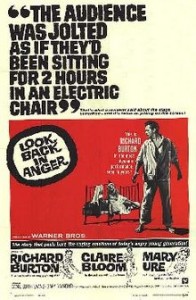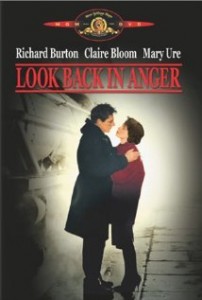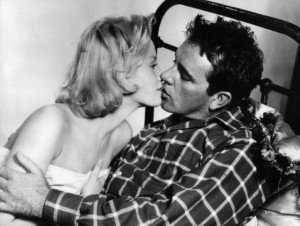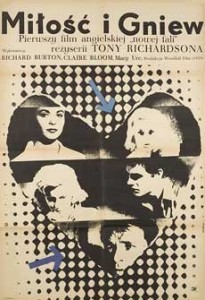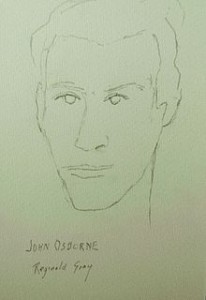Look Back in Anger ***** (1959, Richard Burton, Mary Ure, Claire Bloom) – Classic Movie Review 1474
Director Tony Richardson admirably brings so-called ‘Angry Young Man’ playwright John Osborne’s famous, world-renowned play for London’s Royal Court Theatre to the screen in 1959 with all its challenging words, raging spirit and anti-establishment appeal intact. Look Back in Anger transformed English theatre and it is great to have a contemporary, kind of record of it.
Quatermass writer Nigel Kneale makes a grand job of extending the play into a screenplay, hired on the advice of theatre critic Kenneth Tynan, who had prompted the success of the play. Osborne was relieved not to have to provide the screenplay and handed over story rights for only £2,000.
It appears to be the story of a love triangle, but it is really all about one man’s feeling of alienation from society and the people around him, and the whole issue of class that was so relevant at the time in the UK, and still is to some considerable extent. The piece is highlighted in tits anti-hero’s tirades against middle-class smugness in the post-atomic world. The middle classes rule the government and the media, and therefore control the working classes.
It is produced by Bond producer Harry Saltzman, with the assistance of Gordon L T Scott. Against Saltzman’s resistance, Osborne insisted that Richardson must direct the film as he had directed the original theatrical production, even though he had no track record in feature films. Original backers J Arthur Rank pulled out, objecting to Richardson. Saltzman and Richardson persuaded international star name Richard Burton to take on the star role at a much lower fee than his Hollywood rate. Hiring Burton finally made it possible for Look Back in Anger to become a movie.
Eagerly grabbing his opportunity for a role that he is a perfect fit for (apart maybe from being slightly too old at 34), Burton is on fire and turns in one of his best ever film performances. He positively relishes his nasty, incisive dialogue as its ghastly anti-hero, Fifties spiteful whinger Jimmy Porter, an intelligent and educated but disaffected young man of working class origin.
He works as a market stallholder, but spends his spare time cursing and bitching and railing against the world, sometimes with just cause, while he abuses his upper-middle-class, impassive wife Alison (Mary Ure) and has an affair with her haughty best friend Helena (Claire Bloom). In one way, you don’t want to spend any time with this awful user/ loser. In another, it’s like watching a car wreck or a deadly snake. It’s mesmerising.
Meanwhile Cliff, an amiable Welsh lodger, attempts to keep the peace between Jimmy and Alison. He’s played by Gary Raymond, replacing Alan Bates from the stage production, though, despite this setback, it was Bates who would go on to be a star and not Raymond. It’s ironic that Richardson was able to film his stage successes Look Back in Anger and A Taste of Honey, but allowed the original casts to be largely dumped.
Look Back in Anger is a bitter, unpleasant, nihilistic, misogynistic play about a hollow man, though it changed the face of British theatre in the late Fifties for ever and now tells us a lot about the state of Britain back then. Much of its anger is uncomfortably directed against the female characters, reflecting Osborne’s own problems with women.
Unlike the play, the film was weak at the box-office. It opened in London with an audience-restricting X certificate on 29 May 1959 during one of the capital’s rare heatwaves and nobody wanted to be inside a cinema. It went on to flop in America. It didn’t do well at awards time, either, even at home. Nominated for four 1959 BAFTA Awards, including Best Actor for Burton, it did not win any.
The play was premiered at London’s Royal Court Theatre on 8 May 1956 by the English Stage Company, with Richardson directing. The cast was Kenneth Haigh (Jimmy), Alan Bates (Cliff), Mary Ure (Alison) and Helena Hughes (Helena). The title is a quote from the poet James Thurber: ‘Let us not look back in anger, nor forward in fear, but around in awareness.’
Edith Evans, Gary Raymond, Donald Pleasence, Phyllis Neilson-Terry and Walter Hudd also appear. So do George Devine, the artistic director of the English Stage Company, to whom Osborne most owed his success, Devine’s long-time collaborator Glen Byam Shaw as Colonel Redfern, and two other members of the English Stage Company, Nigel Davenport and Alfred Lynch in tiny roles as barflies.
Look Back in Anger is an uncomfortably autobiographical piece based on Osborne’s unhappy marriage to actress Pamela Lane and their life in cramped rooms in Derby, where the play and film are set. Though there was filming in Derby, the market scenes are shot in London in Deptford Market and Dalston Junction railway station, and most of the film was shot at Elstree Studios in September 1958, so disappointingly there’s very little feel or sight of the English Midlands at the time. After the first production of the play in London, Osborne began a relationship with Mary Ure and divorced his wife to marry her in 1957.
Richardson went on to film Shelagh Delaney’s A Taste of Honey in 1961. In 1964 he won the Academy Award for Best Director for Tom Jones. Married to Vanessa Redgrave in the Sixties, the bisexual director died of AIDS-related causes at age 63 in 1991. His last film was Blue Sky, released in 1994.
It is remade by Lindsay Anderson in 1980 with Malcolm McDowell as Look Back in Anger and again in 1989 with Kenneth Branagh and Emma Thompson as Look Back in Anger.
© Derek Winnert 2014 Classic Movie Review 1474
Check out more reviews on http://derekwinnert.com/

